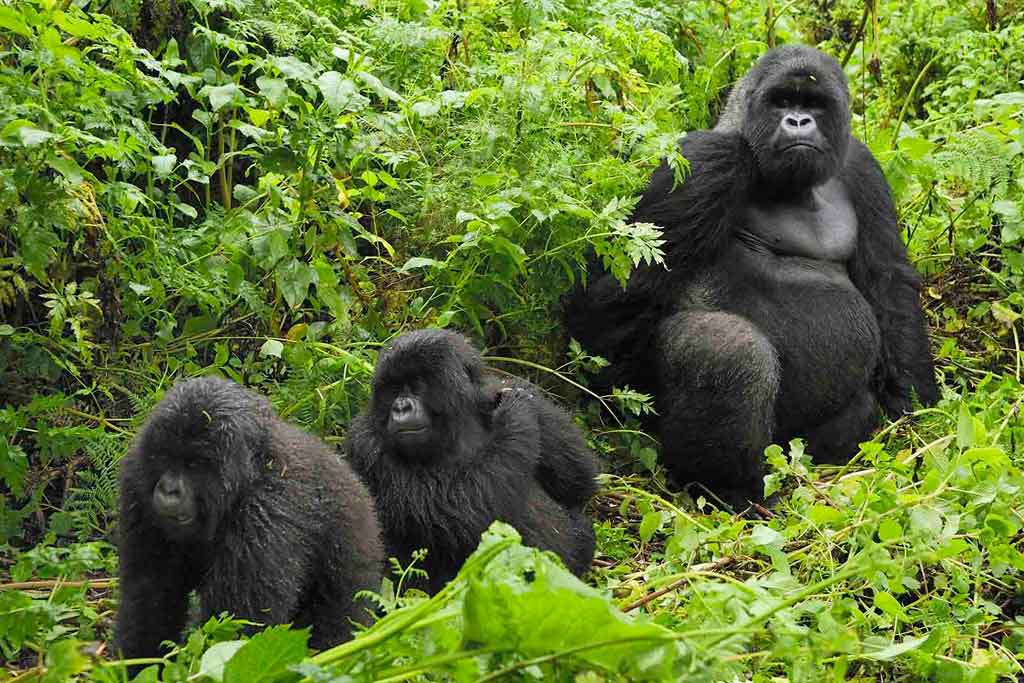Mountain Gorillas Social Life & Behavior: Some people think that gorillas are violent and territorial animals, but that is a myth. Quite the opposite, they are gentle and non-territorial primates, which means that they do not stop other animals entering their living area. Furthermore, since they continually travel in search of food, they cannot control one area. BOOK NOW
 Similar to other primates, they are very social animals that live in groups. Life in society helps them to survive. Males protect females and the offspring of the group, and in turn, the dominant male can access the females that are in heat.
Similar to other primates, they are very social animals that live in groups. Life in society helps them to survive. Males protect females and the offspring of the group, and in turn, the dominant male can access the females that are in heat.
Gorillas live in groups called troops. Troops tend to be made of one adult male or silverback, multiple adult females and their offspring. However, multiple-male troops also exist. A silverback is typically more than 12 years of age, and is named for the distinctive patch of silver hair on his back, which comes with maturity. Silverbacks also have large canine teeth that also come with maturity. Both males and females tend to emigrate from their natal groups. For mountain gorillas, females disperse from their natal troops more than males. Mountain gorillas and western lowland gorillas also commonly transfer to second new groups
The troops are typically composed of 2 to 30 members; from which 1 to 4 are male adults and the rest are blackbacks, adult females, and their offspring. Groups of western lowland gorillas (Gorilla gorilla gorilla) appear to be smaller: up to 5 individuals. Their composition varies over time due to events like the death of the young and the migration of individuals when they reach sexual maturity. In average, groups have between 2 and 12 members and move around an area of 4 to 25 square kilometers.
All males get the silvery hair patch on their back when they reach adulthood, but only one of them becomes the leader.
The “Silverback” who leads a group, is easily recognized by a patch of silvery fur that covers its back. However, all males get that hair patch on their back when they reach maturity, but only one becomes the leader. It is the oldest, usually an adult over 12 years of age, and the strongest, the one that becomes the master since it has the great responsibility to protect all members of his group. Their tasks are: taking decisions, resolve conflicts, defend the group against the enemies, produce offspring, find new sites to feed, define the home area, when to eat, sleep, and so on. It also has the exclusive right to mate with females.
In some groups, another adult male can function as second in command, but always subordinated to the leader, and in particular cases, several “silverback” can cohabit and handle support. Sometimes, several single males get away from the group and decide to travel together.
Breeding females organize in a hierarchy, according to the time in which they joined the troop. Therefore, the first arriving has a higher status than newcomers, and so on.
Mature males also tend to leave their groups and establish their own troops by attracting emigrating females. However, male mountain gorillas sometimes stay in their natal troops and become subordinate to the silverback. If the silverback dies, these males may be able to become dominant. In a single male group, when the silverback dies, the females and their offspring disperse and find a new troop. Without a silverback to protect them, the infants will likely fall victim to infanticide. Joining a new group is likely to be a tactic against this. However, while gorilla troops usually disband after the silverback dies, female eastern lowlands gorillas and their offspring have been recorded staying together until a new silverback transfers into the group. This likely serves as protection from leopard or mate with the females
Social Habits.
Typically, both females and males leave the group in which they were born and join other after reaching sexual maturity. Males have to do it to avoid a conflict with the dominant leader for the females, and they must leave to avoid the dominant male to mate up with their female descendants and prevent crossbreeding. The exception occasionally occurs in mountain gorillas (Gorilla beringeiberingei) groups where blackbacks can stay in their birth group even so they have a subordinate role to the dominant “silverback”.
Some males may venture to defeat the leader to become the new one.
Some mature males may try to beat the head of a group to become the new leader. If one or more unrelated females join a lone individual, a new social group that increases over time is created.
If the leader dies, the other males take the opportunity to mate with the females available and can become the next leader. But in the case of the eastern lowland gorilla groups (Gorilla beringei graueri), female gorillas can stay in the same place waiting until a new dominant male arrives and protect them.
Gorillas do not sleep in the same place two consecutive nights.
Gorillas’ daily life is quiet. Adult females are usually not related to each other, and it is common to compete to be near the leader, as this provides further protection to them and their offspring. During the morning and afternoon, they focus on their food, and they take a nap at noon. Later they resume the search for food and at the end of the day, before nightfall, they build nests in the trees or on the ground to sleep at night. Gorillas build nests in different locations, a new one every day as gorillas do not sleep in the same place two consecutive nights since they keep moving while foraging, and they do not stay at the same location for more than one day to avoid depleting their food sources.
Grooming among gorillas is important, but not as important as in other primates.
The silverback is the center of the troop’s attention, making all the decisions, mediating conflicts, determining the movements of the group, leading the others to feeding sites, and taking responsibility for the safety and well-being of the troop. Younger males subordinate to the silverback, known as black backs, may serve as backup protection. Black backs are aged between 8 and 12 years and lack the silver back hair. The bond that a silverback has with his females forms the core of gorilla social life. Bonds between them are maintained by grooming and staying close together. Females form strong relationships with males to gain mating opportunities and protection from predators and infanticidal outside males. However, aggressive behaviors between males and females do occur, but rarely lead to serious injury. Relationships between females may vary. Maternally related females in a troop tend to be friendly towards each other and associate closely. Otherwise, females have few friendly encounters and commonly act aggressively towards each other.
Females may fight for social access to males and a male may intervene. Male gorillas have weak social bonds, particularly in multiple-male groups with apparent dominance hierarchies and strong competition for mates. Males in all-male groups, though, tend to have friendly interactions and socialize through play, grooming, and staying together and occasionally they even engage in homosexual interactions. Severe aggression is rare in stable groups, but when two mountain gorilla groups meet, the two silverbacks can sometimes engage in a fight to the death, using their canines to cause deep, gaping injuries.
Competition
One possible predator of gorillas is the leopard. Gorilla remains have been found in leopard scat, but this may be the result of scavenging. When the group is attacked by humans, leopards, or other gorillas, an individual silverback will protect the group, even at the cost of his own life.
The supreme threat to the Mountain Gorillas is human encroachment for settlement around them. previously there was a slash as well as burn mentality however, through an educational program by the Uganda Wildlife Authority plus cash motivation to the community through the tourism industry that the gorillas within Uganda are today no longer as threatened by various poachers as it was in the DRC. Additionally they are threatened by various diseases transmitted by human visitors into the park, and for that reason the Uganda Wildlife Authority has set up strict rules to prevent spreading of such diseases
